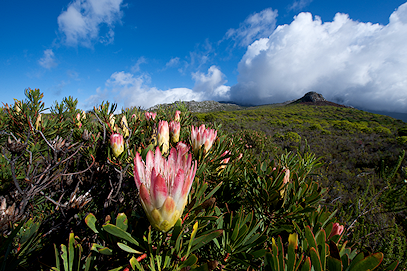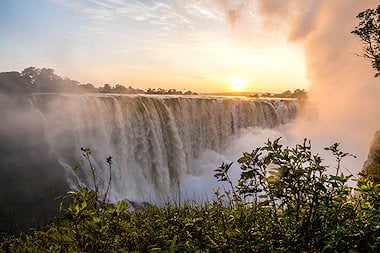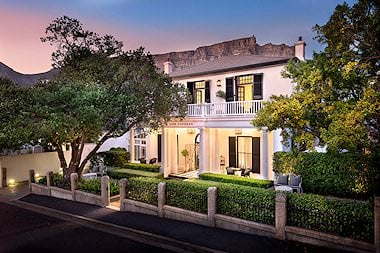South Africa's Table Mountain National Park
Help Me Plan- Home
- >
- African Travel
- >
- South Africa
- >
- National Parks
- >
- Table Mountain National Park
Table Mountain National Park Destination Guide
Table Mountain National Park anchors Cape Town with its iconic flat-topped summit, dramatic cliffs, and biodiverse fynbos. Proclaimed in 1998, the park protects the Cape Peninsula’s unique flora and fauna, scenic beaches, and coastal mountains. Visitors enjoy cableway rides, panoramic viewpoints, hiking trails, and easy access from the city’s central neighborhoods.
Getting There
By Air: A quick flight from OR Tambo International Airport takes visitors directly to Cape Town. Table Mountain National Park is a half-hour drive (25 km) from this airport via the N2. Once you arrive in Cape Town, an expert guide can transfer you to the park in a private, air-conditioned vehicle.
By Road: Table Mountain National Park is centrally located in Cape Town and reachable from various access points. From accommodations in the city, you will be at most 20 minutes from entering the park.
Weather & Best Time To Visit
Cape Town has wet, cool winters and warm, dry summers. Summer offers abundant outdoor activities and long daylight hours. Winters rarely reach dramatic lows, and clear days still provide excellent conditions for hiking, viewpoints, and coastal visits. Always prepare for sudden wind and temperature changes year-round.

South Africa’s national flower, the king protea, is one of many plants in this concentration of fynbos — a diverse floral kingdom endemic to the Cape. The animal gem of the park is the rare and endangered Table Mountain ghost frog, found nowhere else in the world. Other species found in the park include Cape grysbok, bontebok, and the African penguin, which nest on beach borders of the park. It is one of several African penguin colonies along the South African and Namibian coasts.
Safaris and Tours that visit Table Mountain
Enjoy a journey from the cosmopolitan city of Cape Town to the wilds of Kruger National Park, and onward to the majestic Victoria Falls.
Three of Southern Africa's top travel destinations combine to make this an unforgettable experience. It is one of the most popular tours offered by African Sky.
Two of the Western Cape’s iconic destinations — Cape Town and the beautiful coastal stretch of the Garden Route — captivate visitors who book this private tour.
This guided tour of the highlights in and around Cape Town provides visitors who want to sit back, relax and enjoy a hassle-free tour with the perfect option.
Reasons to visit Table Mountain National Park
So much to see
The mountain has much more to offer than the distant view of its legendary flat top. Table Mountain National Park is home to over 900 different species of fynbos. Visitors can view various animals, including penguin and southern right whale (June to November), antelope, baboon, snake, tortoise, insect, and bird.
Vistas
Visitors can enjoy endless views of Cape Town and the peninsula from various vantage points on Table Mountain. The park has several hiking trails, and famous climbs include Silvermine, Lion's Head, and Table Mountain. You can also take the aerial cableway to the top of the mountain. The beaches offer exceptional views of the Atlantic — with Noordhoek, Kommetjie, and Scarborough among the most popular.
A Wonder of Nature
As of 2011, Table Mountain is one of the New7Wonders of Nature. In Cape Town, you will feel privileged to be seeing this landmark daily, from wherever you are in the city. Additionally, it is not only beautiful to admire but also to explore, and hiking up the mountain and spending time at the top are unmissable experiences.
Experiences to Savor at Table Mountain National Park
Visitors can savor an incredible variety of experiences in Table Mountain National Park. Its collection comprises a unique range of coasts, forests, and mountains, from Boulders Beach to the point where the peninsula sinks into the ocean.

Table Mountain
You can summit the mountain by doing one of the several day-hikes or take a ride in the aerial cableway. You can even opt to spend the night on Table Mountain. The wonder is ever-present and never ceases to inspire.
Silvermine
Silvermine is located in the middle of Table Mountain National Park and offers activities such as birdwatching, mountain biking, and hikes through the fynbos, for which the area is renowned. You can also witness magnificent views of Hout Bay from here, and there is a hike to Kalk Bay (9.5 km).
Boulders Penguin Colony
The penguin colony at Boulders Beach near Simon's Town is one of the largest colonies of the endangered African penguin. Visitors are immersed in the colony from three boardwalks. The beach is also an inviting place for a swim, as it is sheltered from currents by the boulders.Useful Information
History
Human history around Table Mountain dates back 30,000 years to the Stone Age. It is older than many other famous landmarks around the world. Around 2,000 years ago, the Khoisan inhabited the area around Table Mountain and named it “Hoerikwaggo.” The word “Hoerikwaggo” translates to “Mountain in the Sea.” The first European climbed to the top of the mountain in 1503. This honor belongs to Admiral Antonio de Saldanha, a Portuguese navigator who docked his ship in Table Bay. He summited Table Mountain via the Platteklip Gorge and carved a cross into Lion's Head that is still visible today.
During the British occupation of the Cape, three blockhouses were built on Table Mountain, one of which is still in good condition. In the late 1800s, several dams were built in the area to supply water to Cape Town. These dams are no longer used for that purpose but are still accessible to hikers or people seeking to cool down. The aerial cableway has been operating since 1926 and was upgraded in 1997. Table Mountain National Park was founded in 1998 and has since been the most visited national park in South Africa, with millions of visits recorded annually.
Wildlife
You won’t find the Big Five in Table Mountain National Park, but the park is rich in fauna. It is home to several antelope species adapted to the fynbos, like klipspringer, grysbok, common duiker, grey rhebok, and steenbok. Your best chance of catching a glimpse of these animals would be in the early morning. In the Cape of Good Hope section of Table Mountain National Park, you will find larger antelope like eland, red hartebeest, and bontebok. Other mammals include zebra, several species of mongoose, Cape fox, otter, and, of course, baboon.
A large part of the park lies offshore, protecting abundant marine life. The penguin at Boulders Beach are distinctive, but there are also whales to look for, especially southern right and humpback whale. It is also common to see Cape fur seal. Other common sea creatures include dolphin (bottlenose, common, and dusky), great white shark, yellowtail, and Cape salmon. While you visit the national park, there is a good chance of seeing a host of bird species, from woodpecker to birds of prey. Always be aware of the possibility of running into one of the 22 snake species.
Vegetation & Terrain
Table Mountain National Park can be divided into three sections: the Table Mountain section, the Silvermine–Tokai section, and the Cape Point section. The entire area covers 221 square kilometers (85 square miles). The Table Mountain group of rock formations is about 520 million years old. It comprises three different formations. The Graafwater Formation is a 25–65 m layer of sandstone and mudstone in red and purple hues. The Peninsula Formation consists of light gray, pebble-like sandstone. This layer is 700 m thick and forms the bulk of Table Mountain. The last is the Pakhuis Formation, found near the top of Table Mountain.
The most common vegetation type in Table Mountain National Park is fynbos. Fynbos is an ancient vegetation type that dates back tens of millions of years. Four principal plant groups dominate fynbos here: protea, erica, restio, and geophyte. Fynbos typically requires periodic fire, often on cycles of roughly 10–20 years, which is why it thrives in this area. Other vegetation types include renosterveld and Afromontane forest. Renosterveld encompasses grass-like shrubs found on the slopes of the mountain and is highly endangered. Afromontane forest is less prevalent and depends on frequent rainfall.
Activities
Whether you like to be adventurous and climb mountains, experience a nice view from the comfort of your vehicle, breathe in the ocean air, or have up-close encounters with animals, the national park has an activity for everyone. There are a variety of hiking trails and even overnight trails in all three sections. This activity is highly recommended, as it allows you to take in the beauty of the national park. For people who prefer to keep their heart rate down, a cool dip in one of the dams is a great way to relax. Mountain biking is a prevalent activity, with various available trails.
At the seaside, there are activities like fishing, snorkeling and scuba diving, surfing and kiteboarding, and penguin encounters. A different way to view the Mother City is by paragliding from Signal Hill or Lion's Head, usually with a landing spot in Camps Bay.












